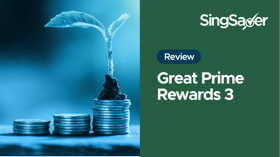The extension of the community circuit breaker brings renewed worries.
With more businesses forced into a longer shutdown period, the risk to jobs and livelihoods increase. The Monetary Authority of Singapore has just confirmed that the country is looking at an impending recession.
The immediate problem facing many of us is how to continue to meet expenses in the face of pay cuts and retrenchments. At a time like this, we all could do with some sources of money we can look at exploring while making sure we avoid money mistakes.
Luckily, these do exist. From insurance cashback to credit card perks and personal loans, here are 3 sources of money to tap into, which you may not have considered before.
1. Endowment plan cashback
If you’re currently making monthly payments that go into a type of savings plan with an insurance company (instead of a bank), you’re servicing what is known as an endowment plan. Depending on the type of endowment plan you subscribed to, you may be able to withdraw a portion of your plan’s accumulated value to help you tide over the circuit breaker period.
Check your endowment plan documents to see if there’s a cashback option — not every endowment offers cashback. If yours does, you are entitled to make a withdrawal from your plan. You can withdraw a set amount of money every year, but if you don’t, the amount rolls over to next year. This means that if you’re a few years into your cashback endowment plan, your cashback sum has snowballed.
Here’s an example to illustrate:
| Endowment Plan Year | Cashback Amount Each Year | Cashback Available | Cashback Triggered |
| Year 3 | $3,000 | $3,000 | N/A |
| Year 4 | $3,000 | $6,000 | N/A |
| Year 5 | $3,000 | $9,000 | $9,000 withdrawn at end of Year 5 Cashback remainder = $0 |
| Year 6 | $3,000 | $3,000 | N/A |
| Year 7 | $3,000 | $6,000 | N/A |
In the above example, let’s say you’ve completed 5 years of your endowment plan. At the end of 5 years, you decide to trigger your cashback option and withdraw everything, which amounts to $9,000. The cashback amount remaining in your endowment plan becomes $0 after the withdrawal.
At the end of Year 6, your endowment plan cashback rises to $3,000 again, and continues accumulating every year until you make another withdrawal or your endowment plan ends, whichever is sooner.
Typically, you will only be able to exercise your cashback option at the end of Year 2, so if you’ve just started your endowment plan, you’re out of luck.
A crucial difference to note here: triggering a cashback is not the same as surrendering your endowment plan. The former is a built-in feature, which you are entitled to exercise without penalty and within limits, while the latter is often an expensive option with high penalties that almost certainly guarantees a loss.
Always remember it is far better to complete your endowment plan so that you can get back the highest payout.
2. Policy loan
If you have an active whole or universal life plan, you can borrow against your policy to get the money you need.
This is possible because whole life plans have two components to them — the death benefit (paid out to your beneficiaries upon death) and the surrender value (paid out to you when you surrender the whole life plan).
The surrender value of your whole life plan increases over time. Therefore, whole life plans that have been active for a while will have accumulated a cash value, which you can borrow against.
Typically, you will be able to borrow up to 90% of the current surrender value of your policy. However, know that you are not actually taking money out of your whole life policy. Instead, you are taking a loan from your insurer, using the cash value of your policy as collateral. Your insurer will charge interest on your loan.
Here’s a simplified example to illustrate the above:
| Duration | Death Benefit | Surrender Value | Loan Triggered |
| Year 10 | $200,000 | $95,000 | N/A |
| Year 11* | $200,000 | $101,000 | $20,000 |
| Year 12 | $200,000 | $87,000 | N/A |
| Year 13 | $200,000 | $93,000 | N/A |
*Note that from the point you are granted the loan, your policy’s surrender value is immediately reduced by the loan amount, i.e. $20,000. While your death benefit remains the same, the loan and interest owed will be deducted from the final payout.
Unlike a traditional loan, you do not actually have to pay back a policy loan, as you are essentially borrowing from yourself. However, do note that the interest on your loan will compound and add to the total sum owed. If this sum owed reaches the cash value of your policy, your policy can lapse, which means you will lose your insurance coverage.
This is why it’s crucial to make sure your loan does not reach the size of your cash value.
You can manage this by regularly paying the interest amount, so that your total owed remains lower than your policy’s cash value. Another option is to make a partial or full repayment of your loan amount (plus interest) to your policy.
The latter is a good step to take if you wish to preserve the death benefit for your beneficiaries, as any loan amount and interest accrued will be deducted from your policy’s final payout (i.e deducted from your death benefit or the surrender value). So, it is best to be prudent when borrowing against your whole life policy, lest you risk disrupting your future financial plans or estate planning.
3. Credit card perks
Credit cards can act as a source of money if you know how to use them properly. No, we don’t mean using them for cash advances, which is generally a bad idea. Instead, credit cards can help us with cashback, miles and reward points.
Cashback credit cards are probably the most well-known, given their no-fuss nature. Just be sure to meet the minimum monthly spending and you’ll get rebates on your spending.
You may be looking forlornly at your air miles credit cards right now (we know, us too!) but don’t despair yet. Your air miles can be used for more than just plane tickets and travel perks!
If you have a bank of KrisFlyer miles that are close to expiring, hop on over to KrisShop.com and treat yourself to some nice things like Le Cruset kitchenware, Parker pens, Bang & Olufsen bluetooth speakers and even DIPTYQUE home candles that you’ve vying for, for a while.
If your kids are sulking because they miss their friends, and you happen to have an AsiaMiles account, use your miles to buy them the latest Nintendo or Playstation games to cheer them up. There’re also plenty of other special promotions and offers, which you can pay for using air miles.
The great thing is that credit cards also provide money in the form of rewards points, which you can use in a variety of ways. For one, you can use them to make payment towards your credit card bills or to make a charity donation to provide some extra help during the COVID-19 pandemic. Love shopping on Amazon? Use your rewards points from Citi or American Express Membership Rewards points to pay for your shopping spree.
Check your bank for gift cards and vouchers for your favourite brands while you’re at it. Use your points to redeem the vouchers you want for instant money.
Read these next:
Deferring Insurance Premium Payment During COVID-19: A Complete Guide
Best Personal Loans In Singapore With The Lowest Interest Rates (2020)
Understanding Personal Loans: Why And When Should You Use It?
What Should You Do If You Can’t Pay Your Credit Card Bill?
5 Ways to Cope With Financial Setbacks Hitting Singaporeans Hard Amid COVID-19
Similar articles
Guide to Universal Life Insurance in Singapore
Is Insurance An Expense Or An Asset?
What’s An Insurance Policy Loan, And When Should You Cash In On It?
All The Insurance Terms And Lingo In Your Policy, Explained
Prudential PRUWealth & PRUWealth II Review
What Most Singaporeans Don’t Know About Insurance Returns
Cash Value Life Insurance – How Does it Work, and Who is it For?
3 Must-have Insurance Types For The YOLO & FOMO Generation










